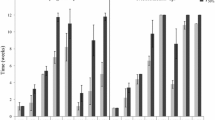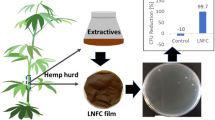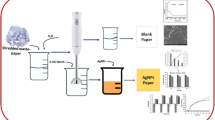Abstract
In this study, different methods for incorporating mixed or laminar copper microparticles (CuMPs) during papermaking were evaluated to determine the optimum paper-making process and correlate particle concentration and shape with antimicrobial activity. The addition of CuMPs during the disintegration of dry pulp stage was observed to produce a paper with uniformly distributed CuMPs, as determined through optical microscopy and UV–Vis spectroscopy analyses by measuring absorbance spectra in different areas of papers. Determination of two indices related to the concentration and distribution of copper will allow to predict the copper content in other papers. CuMP-paper samples were evaluated for structural, optical, and mechanical strength properties according to paper industry standards. Quantitative analyses by atomic absorption showed that between 24 and 39% of CuMPs were embedded in the paper fibre, independent of particle type. Finally, antibacterial activity analyses were performed according to ISO 20645 and ISO 20743. The results showed that papers with 0.30 g of incorporated CuMPs have antimicrobial activity, independent of particle morphology, with effects observed towards Gram (+) and Gram (−) bacteria and fungus. Furthermore, the evaluation of antimicrobial activity at different times of exposure to the microorganisms showed differences in effects that were dependent on the shape of the CuMPs incorporated into paper, where laminar particles exerted a sufficient effect, while no or a slight effect was observed for mixed CuMPs against Aspergillus niger.
Graphic abstract














Similar content being viewed by others
References
Adeleye AS, Conway JR, Perez T et al (2014) Influence of extracellular polymeric substances on the long-term fate, dissolution, and speciation of copper-based nanoparticles. Environ Sci Technol 48:12561–12568. https://doi.org/10.1021/es5033426
Amini E, Azadfallah M, Layeghi M, Talaei-Hassanloui R (2016) Silver-nanoparticle-impregnated cellulose nanofiber coating for packaging paper. Cellulose 23:557–570. https://doi.org/10.1007/s10570-015-0846-1
Ashori A, Raverty WD, Harun J (2005) Effect of chitosan addition on the surface properties of kenaf (Hibiscus cannabinus) paper. Fibers Polym 6:174–179. https://doi.org/10.1007/BF02875611
Azam A, Ahmed O et al (2012) Antimicrobial activity of metal oxide nanoparticles against Gram-positive and Gram-negative bacteria: a comparative study. Int J Nanomed 7:6003–6009. https://doi.org/10.2147/IJN.S35347
Cano AP, Gillado AV, Montecillo AD, Herrera MU (2018) Copper sulfate-embedded and copper oxide-embedded filter paper and their antimicrobial properties. Mater Chem Phys 207:147–153. https://doi.org/10.1016/j.matchemphys.2017.12.049
Chardon WJ, Menon RG, Chien SH (1996) Iron oxide impregnated filter paper (Pi test): a review of its development and methodological research. Nutr Cycl Agroecosyst 46:41–51. https://doi.org/10.1007/BF00210223
Chen PC, Li YC, Ma JY et al (2016) Size-tunable copper nanocluster aggregates and their application in hydrogen sulfide sensing on paper-based devices. Sci Rep 6:1–9. https://doi.org/10.1038/srep24882
Dankovich TA, Gray DG (2011) Bactericidal paper impregnated with silver nanoparticles for point-of-use water treatment. Environ Sci Technol 45:1992–1998. https://doi.org/10.1021/es103302t
Dankovich TA, Levine JS, Potgieter N et al (2016) Inactivation of bacteria from contaminated streams in Limpopo, South Africa by silver- or copper-nanoparticle paper filters. Environ Sci Water Res Technol 2:85–96. https://doi.org/10.1039/c5ew00188a
Dankovich TA, Smith JA (2014) Incorporation of copper nanoparticles into paper for point-of-use water purification. Water Res 63:245–251. https://doi.org/10.1016/j.watres.2014.06.022
Dector A, Galindo-de-la-Rosa J, Amaya-Cruz DM et al (2017) Towards autonomous lateral flow assays: paper-based microfluidic fuel cell inside an HIV-test using a blood sample as fuel. Int J Hydrog Energy 42:27979–27986. https://doi.org/10.1016/j.ijhydene.2017.07.079
Emam HE, Manian AP, Široká B et al (2014) Copper(I)oxide surface modified cellulose fibers—synthesis, characterization and antimicrobial properties. Surf Coat Technol 254:344–351. https://doi.org/10.1016/j.surfcoat.2014.06.036
Esquivel JP, Del Campo FJ, Gómez De La Fuente JL et al (2014) Microfluidic fuel cells on paper: meeting the power needs of next generation lateral flow devices. Energy Environ Sci 7:1744–1749. https://doi.org/10.1039/c3ee44044c
Esquivel JP, Buser JR, Lim CW et al (2017) Single-use paper-based hydrogen fuel cells for point-of-care diagnostic applications. J Power Sources 342:442–451. https://doi.org/10.1016/j.jpowsour.2016.12.085
Fawcett RG, Collis-George N (1967) A filter-paper method for determining the moisture characteristics of soil. Aust J Exp Agric 7:162–167. https://doi.org/10.1071/EA9670162
Ghorbani HR (2014) Biological coating of paper using silver nanoparticles. IET Nanobiotechnol 8:263–266. https://doi.org/10.1049/iet-nbt.2013.0039
Ghorbani HR (2017) Preparation of chitosan-copper nanoparticles coated Kraft paper, characterization and its antimicrobial activity. J Nanoanal 4:320–323. https://doi.org/10.22034/JNA.2018.552110.1049
Gong J, Li J, Xu J et al (2017) Research on cellulose nanocrystals produced from cellulose sources with various polymorphs. RSC Adv 7:33486–33493. https://doi.org/10.1039/c7ra06222b
Goswami M, Das AM (2018) Synthesis of cellulose impregnated copper nanoparticles as an efficient heterogeneous catalyst for C–N coupling reactions under mild conditions. Carbohyd Polym 195:189–198. https://doi.org/10.1016/j.carbpol.2018.04.033
Hans M, Mathews S, Mücklich F, Solioz M (2016) Physicochemical properties of copper important for its antibacterial activity and development of a unified model. Biointerphases 11:018902. https://doi.org/10.1116/1.4935853
He W, Huang X, Zheng Y et al (2018) In situ synthesis of bacterial cellulose/copper nanoparticles composite membranes with long-term antibacterial property. J Biomater Sci Polym Ed 29:2137–2153. https://doi.org/10.1080/09205063.2018.1528518
Holik H (2006) Handbook of paper and board, Sixta. Wiley, Weinheim
Huang X, Hu N, Wang X et al (2017) Copper sulfide nanoparticle/cellulose composite paper: room-temperature green fabrication for NIR laser-inducible ablation of pathogenic microorganisms. ACS Sustain Chem Eng 5:2648–2655. https://doi.org/10.1021/acssuschemeng.6b03003
Imani R, Talaiepour M, Dutta J et al (2011) Production of antibacterial filter paper from wood cellulose. BioResources 6:891–900. https://doi.org/10.15376/biores.6.1.891-900
Jain S, Bhanjana G, Heydarifard S et al (2018) Enhanced antibacterial profile of nanoparticle impregnated cellulose foam filter paper for drinking water filtration. Carbohyd Polym 202:219–226. https://doi.org/10.1016/j.carbpol.2018.08.130
Jia B, Mei Y, Cheng L et al (2012) Preparation of copper nanoparticles coated cellulose films with antibacterial properties through one-step reduction. ACS Appl Mater Interfaces 4:2897–2902. https://doi.org/10.1021/am3007609
Jokerst JC, Emory JM, Henry CS (2012) Advances in microfluidics for environmental analysis. Analyst 137:24–34. https://doi.org/10.1039/c1an15368d
Kaweeteerawat C, Chang CH, Roy KR et al (2015) Cu nanoparticles have different impacts in Escherichia coli and Lactobacillus brevis than their microsized and ionic analogues. ACS Nano 9:7215–7225. https://doi.org/10.1021/acsnano.5b02021
Kim J, Lee H, Kim HS (2010) Beam vibration control using cellulosebased electro-active paper sensor. Int J Precis Eng Manuf 11:823–827. https://doi.org/10.1007/s12541-010-0099-8
Koziróg A, Brycki B, Olejnik K et al (2019) Cellulose products modified with monomeric and gemini surfactants: antimicrobial aspects. Cellulose 26:5559–5570. https://doi.org/10.1007/s10570-019-02475-0
Kunkel HG (1951) Electrophoresis of proteins on filter paper. J Gen Physiol 35:89–118. https://doi.org/10.1085/jgp.35.1.89
Lázaro Martínez JM, Chattah AK, Monti GA et al (2008) New copper(II) complexes of polyampholyte and polyelectrolyte polymers: solid-state NMR, FTIR, XRPD and thermal analyses. Polymer 49:5482–5489. https://doi.org/10.1016/j.polymer.2008.10.011
Li H, Cui R, Peng L et al (2017) Preparation of antibacterial cellulose paper using layer-by-layer assembly for cooked beef preservation at ambient temperature. Polymers 10:15. https://doi.org/10.3390/polym10010015
Liang J, Wang Y, Liu B (2012) Paper-based fluoroimmunoassay for rapid and sensitive detection of antigen. RSC Adv 2:3878–3884. https://doi.org/10.1039/c2ra20156a
Liu S, Zhang XX (2016) Small colony variants are more susceptible to copper-mediated contact killing for Pseudomonas aeruginosa and Staphylococcus aureus. J Med Microbiol 65:1143–1151. https://doi.org/10.1099/jmm.0.000348
Łojewska J, Missori M, Lubańska A et al (2007) Carbonyl groups development on degraded cellulose. Correlation between spectroscopic and chemical results. Appl Phys A Mater Sci Process 89:883–887. https://doi.org/10.1007/s00339-007-4220-5
Mahadeva SK, Yun S, Kim J (2011) Flexible humidity and temperature sensor based on cellulose-polypyrrole nanocomposite. Sens Actuators A Phys 165:194–199. https://doi.org/10.1016/j.sna.2010.10.018
Martins NCT, Freire CSR, Neto CP et al (2013) Antibacterial paper based on composite coatings of nanofibrillated cellulose and ZnO. Colloids Surf A Physiochem Eng 417:111–119. https://doi.org/10.1016/j.colsurfa.2012.10.042
Maurer HW (2009) Starch in the paper industry, 3rd edn. Elsevier Inc, Amsterdam
Mei JV, Alexander JR, Adam BW, Hannon H (2001) Use of filter paper for the collection and analysis of human whole blood specimens. J Nutr 13:1631–1636. https://doi.org/10.1093/jn/131.5.1631S
Mousavi Ehteshami SM, Asadnia M, Tan SN, Chan SH (2016) Paper-based membraneless hydrogen peroxide fuel cell prepared by micro-fabrication. J Power Sources 301:392–395. https://doi.org/10.1016/j.jpowsour.2015.10.038
Muthulakshmi L, Varada Rajalu A, Kaliaraj GS et al (2019) Preparation of cellulose/copper nanoparticles bionanocomposite films using a bioflocculant polymer as reducing agent for antibacterial and anticorrosion applications. Compos B Eng 175:107177. https://doi.org/10.1016/j.compositesb.2019.107177
Nakbanpote W, Goodman BA, Thiravetyan P (2007) Copper adsorption on rice husk derived materials studied by EPR and FTIR. Colloids Surf A Physiochem Eng 304:7–13. https://doi.org/10.1016/j.colsurfa.2007.04.013
Nechita P, Bobu E, Parfene G et al (2015) Antimicrobial coatings based on chitosan derivatives and quaternary ammonium salts for packaging paper applications. Cellul Chem Technol 49:625–632
Nery EW, Kubota LT (2013) Sensing approaches on paper-based devices: a review. Anal Bioanal Chem 405:7573–7595. https://doi.org/10.1007/s00216-013-6911-4
Ngo YH, Li D, Simon GP, Garnier G (2011) Paper surfaces functionalized by nanoparticles. Adv Coll Interface Sci 163:23–38. https://doi.org/10.1016/j.cis.2011.01.004
Pang B, Yan J, Yao L et al (2016) Preparation and characterization of antibacterial paper coated with sodium lignosulfonate stabilized ZnO nanoparticles. RSC Adv 6:9753–9759. https://doi.org/10.1039/c5ra21434c
Quaranta D, Krans T, Santo CE et al (2011) Mechanisms of contact-mediated killing of yeast cells on dry metallic copper surfaces. Appl Environ Microbiol 77:416–426. https://doi.org/10.1128/AEM.01704-10
Salavati-Niasari M, Davar F (2009) Synthesis of copper and copper(I) oxide nanoparticles by thermal decomposition of a new precursor. Mater Lett 63:441–443. https://doi.org/10.1016/j.matlet.2008.11.023
Sequeira S, Cabrita EJ, Macedo MF (2012) Antifungals on paper conservation: an overview. Int Biodeterior Biodegrad 74:67–86. https://doi.org/10.1016/j.ibiod.2012.07.011
Shankar S, Rhim J (2018) Antimicrobial wrapping paper coated with a ternary blend of carbohydrates (alginate, carboxymethyl cellulose, carrageenan) and grapefruit seed extract. Carbohyd Polym 196:92–101. https://doi.org/10.1016/j.carbpol.2018.04.128
Silva N, Ramírez S, Díaz I et al (2019) Easy, quick, and reproducible sonochemical synthesis of CuO nanoparticles. Materials 12:804–817. https://doi.org/10.3390/ma12050804
Szekeres GP, Nemeth Z, Schrantz K et al (2018) Copper-coated cellulose-based water filters for virus retention. ACS Omega 3:446–454. https://doi.org/10.1021/acsomega.7b01496
Tamayo L, Azócar M, Kogan M et al (2016) Copper-polymer nanocomposites: an excellent and cost-effective biocide for use on antibacterial surfaces. Mater Sci Eng C 69:1391–1409. https://doi.org/10.1016/j.msec.2016.08.041
Tsai TT, Huang TH, Chang CJ et al (2017) Antibacterial cellulose paper made with silver-coated gold nanoparticles. Sci Rep 7:1–10. https://doi.org/10.1038/s41598-017-03357-w
Vartiainen J, Motion R, Kulonen H et al (2004) Chitosan-coated paper: effects of nisin and different acids on the antimicrobial activity. J Appl Polym Sci 94:986–993. https://doi.org/10.1002/app.20701
Vincent M, Hartemann P, Engels-Deutsch M (2016) Antimicrobial applications of copper. Int J Hyg Environ Health 219:585–591. https://doi.org/10.1016/j.ijheh.2016.06.003
Wang J, Liu W, Li H et al (2013) Preparation of cellulose fiber-TiO2 nanobelt-silver nanoparticle hierarchically structured hybrid paper and its photocatalytic and antibacterial properties. Chem Eng J 228:272–280. https://doi.org/10.1016/j.cej.2013.04.098
Wang S, Ge L, Song X et al (2012) Simple and covalent fabrication of a paper device and its application in sensitive chemiluminescence immunoassay. Analyst 137:3821–3827. https://doi.org/10.1039/c2an35266d
Warmes SL, Keevil W (2016) Death and genome destruction of methicillin-resistant and methicillin-sensitive strains of Staphylococcus aureus on wet or dry copper alloy surfaces does not involve Fenton chemistry. Appl Environ Microbiol 82:2132–2136. https://doi.org/10.1128/aem.03861-15
Weaver L, Michels HT, Keevil CW (2010) Potential for preventing spread of fungi in air-conditioning systems constructed using copper instead of aluminium. Lett Appl Microbiol 50:18–23. https://doi.org/10.1111/j.1472-765X.2009.02753.x
Xu Y, Li S, Yue X, Lu W (2018) Review of Silver nanoparticles (AgNPs)-cellulose antibacterial composites. BioResources 13:2150–2170. https://doi.org/10.15376/biores.13.1.Xu
Zhai L, Park J, Lee JY et al (2018) Synthesis, characterization, and antibacterial property of eco-friendly Ag/cellulose nanocomposite film. Int J Polym Mater Polym Biomater 67:420–426. https://doi.org/10.1080/00914037.2017.1342247
Zhang YX, Huang M, Li F, Wen ZQ (2013) Controlled synthesis of hierarchical CuO nanostructures for electrochemical capacitor electrodes. Int J Electrochem Sci 8:8645–8661
Acknowledgments
The authors would like to thank Eckart Eitner, Raúl González, Cristian Segura, and Felipe Torres of the CMPC; Nancy Pérez and Rodrigo del Canto of the ICono UDD technological development office; and Benjamín Erranz and INTA for antimicrobial analysis services. Additional thanks to the funding granted by a UDD internal research competition and to an UDD institutional contribution. R. Lavín acknowledges financial support in Chile from the Basic Financing for Scientific and Technological Centres of Excellence under Grant AFB180001.
Funding
Funding was provided by Universidad del Desarrollo (Grant No. 23400091).
Author information
Authors and Affiliations
Corresponding authors
Ethics declarations
Conflict of interest
The authors declare that they have no conflict of interest.
Additional information
Publisher's Note
Springer Nature remains neutral with regard to jurisdictional claims in published maps and institutional affiliations.
Electronic supplementary material
Below is the link to the electronic supplementary material.
Fig. S1
Bright-field optical micrograph of paper made with 0.30 g of T1 CuMPs; Fig. S2 UV-Vis absorption spectra of different paper areas containing T1 CuMPs incorporated following methods (a) 1 and (b) 2. Fig. S3 UV-Vis absorption spectra of papers made with 0.05, 0.10, and 0.30 g of T1, T2, T3, and T4 CuMPs, together with bright-field micrographs (transmission). (b) Plot of the amplitude and area indices versus CuMP concentration and dark-field micrographs (reflection) in the inset; Fig. S4 Optical micrographs at 50× magnification of white paper sheets. Fig. S5 Image of bacterial growth of (a) S. aureus and (b) K. pneumoniae strains in culture dishes with the control white paper and paper with different concentrations of incorporated T1, T2, T3, and T4 copper particles. Fig. S6 Micrographs of the colony sizes of the S. aureus and K. pneumoniae strains stained with Coomassie blue R-250 in the area in contact with paper containing 0.05, 0.10, and 0.30 g of T4 CuMPs, corresponding to samples 11, 12, and 13, respectively. S7. Analysis of the variation of the content of copper particles in the paper, after immersion in a aqueous medium for 24 h. Table S7. Absorbance and amplitude index values, percentage variation of the copper content of paper samples with CuMP before and after being submerged for 24 hours in a aqueous medium. Fig S7. Light and dark field optical micrographs of sample No. 4 of paper with CuMP a) and b) without hydrating, c) and d) after the hydration and drying process. (DOCX 10199 kb)
Appendix
Appendix
Antibacterial activity, according to ISO 20645, was calculated using the formula:
where H corresponds to the inhibition zone; D: total sample diameter and inhibition zone; and d: sample diameter, all expressed in mm.
Antibacterial effect is defined according to the criteria in Table
8 (ISO 20645).
Antibacterial activity, according to ISO 20743, was calculated with the formula:
where A corresponds to the value of the antibacterial activity; F: count of viable bacteria in the control sample (\(F={I}_{g}{C}_{t}-{I}_{g}{C}_{O}\)); G: count of viable bacteria in the experimental samples (\(G={I}_{g}{T}_{t}-{I}_{g}{C}_{T}\)); IgTt: average common logarithm for the number of bacteria obtained from a triplicate of three experimental samples after 18–24 h of incubation; and IgTo: average common logarithm for the number of bacteria obtained from a triplicate of three experimental samples immediately after inoculation.
The value obtained from the formula above was compared with that obtained for controls using interpretation ranges (Table
9) as proposed by the Hohenstein Research Institute (2008).
Rights and permissions
About this article
Cite this article
Contreras, P., Amenabar, A., Apablaza, V. et al. Correlation between the concentration and morphology of copper microparticles and their biocidal effect on paper sheets. Cellulose 27, 4721–4743 (2020). https://doi.org/10.1007/s10570-020-03085-x
Received:
Accepted:
Published:
Issue Date:
DOI: https://doi.org/10.1007/s10570-020-03085-x




